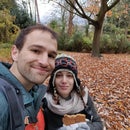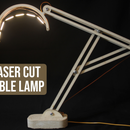Introduction: Roll Top Pencil Case
A while ago I saw an instructable about a beautiful roll top jewelry box, and I immediately fell in love with the concept. The woodworking skills were way out of my league, but the idea stuck. Then, a couple of months ago I bought my laser cutter, and suddenly this dream of mine became a reality. I decided it's time to go back to the roll-top concept and make a roll top pencil box.
In this instructable I'll show you how to make your own roll top pencil case. I think that the roll top pencil case I made turned out really nice - it has a one-of-a-kind look, and most importantly, opening and closing the rolling shutter makes the most satisfying sound (hear for yourself below!!).
There are 2 parts to this instructable:
- Designing the box using an awesome online tool I bumped into.
- Assembly of the box, which is kind of like a fun puzzle.
All files are included for free. Just cut and assemble!
You can have your own roll top pencil case today.
Supplies
Materials:
- A thin plate of wood (320mm x 300mm / 12.5 " x 11.8"). I used 3.5mm plywood, and I made sure to include files to a 3mm version as well (see the step 2 if you want to modify the design).
- Wood glue.
- Wax or oil to make the roll top slide easier.
Tools:
- A laser cutter. Sorry if you don't have one and can't follow along! (laser-cutters cost about 600$ these days so maybe you can get one sometime? sorry!!).
- Optional - a rubber hammer.
Step 1: Video Version
For those who want to see a narrated video version the project, feel free to watch the one I made. That's also the only way you can hear the sound the rolling shutter makes when you open and close it (other than making your own version of course!). Ahhh.... I love it :)
By the way, if you want to support my projects (for free!) subscribing to my new YouTube channel is the best way to do that! :) Thank you so much!
Step 2: Design
Designing 3D objects for laser cutting is pretty hard, especially when there are moving parts and lots of different geometries. I was almost done designing my roll-top pencil case using my favorite CAD software when I ran into a software called Boxes.py. I loved it so much, I just had to share it with you. It turned out way better than my initial model.
Basically, the authors of the boxes.py software realized that many people are making almost identical designs, starting from scratch every time. So, break the cycle, they wrote a python code that lets you start with a basic design and modify it's dimensions and change almost every aspect of it, without actually modeling or drawing anything. They wrote functions mostly for boxes, but other things are available as well. You can join in and write your own contribution if you like.
Once you pick a basic design, you're sent to a different page where you can change many aspects of the design settings. I was designing something similar to a design they call the 'Shutter Box', and so I started with that design (see 2nd image). I measured a few pens and pencils and set the dimensions of the box accordingly. I wanted the box to have two rounded edges and not just one, which is conveniently done with one click. Once I finished setting up the design I wanted, I moved on to the material settings. I used 3.5mm plywood, and you can modify the thickness if you want. Finally, you can compensate for the kerf of your laser cutter (kerf is the part that's removed when material is cut, it should be pretty close to the dimensions of your laser-beam).
Notice that this is just a tool, you have to make sure you feed it with the right inputs and make sure its output is what you expected. For example, I noticed that some holes were missing with my settings, so I had to change the finger-joint settings to make everything work.
Once you're done you can export the results to one of many available formats, or save the design as a URL for others to modify and enjoy. Here's a link to my design in case you want to use it.
Step 3: Cut the Parts
I attached files for two versions of the pencil case, the 3.5mm I made and a 3mm version which might be more useful. I added DXF, AI and SVG files, so pick whatever you like :)
Notice - I already included compensation for the kerf (0.09mm) into the designs, so you don't need to add more in LightBurn (if you're using it).
Place a piece of wood on your laser-cutter and cut it out.
For xTool D1 users (10W) - I cut my 3.5mm plywood with 100% power @ 5mm/sec, 2 passes.
--- June 2024 Update --- I added a version without any kerf offset so can add it yourself as needed.
Step 4: Lay Out the Pieces
Boxes.py do not supply assembly instructions. It's kind of like a puzzle. To get started, lay everything on a table and make sure you have all the pieces (see the image with the same numbering system):
- One rolling shutter and its handle.
- Two side faces.
- A large bottom face and a smaller inner face.
- The front and back faces.
- Two copies of the triplet of short segments.
- Two copies of each kind of the thin arcs (one slightly smaller than the other).
- Four copies of the curved inner corners.
Now that we have everything laid out and a common language, let's get to work and assemble the pencil case!
Step 5: Assemble the Inner Chamber
- Grab one of the side faces (part #2 in the list above).
- Insert the inner face (part #3, smaller part) and the 6 short segments (part # 5) into place. Notice that the short segments are ordered – each segment of the triplet is different. The one with the flat edge should be the outer-most part, and the one with the shallow finger joints should face the inner face (see first and 2nd images).
If you set up the right kerf value, you may need to use a rubber hammer to insert the pieces. Try not to break anything, it should be too hard to squeeze the parts into place.
- Attach the unused side face (3rd image).
- Attach the front and back faces (#4 in th list, see 4th & 5th images in this step).
UPDATE (October 31st, 2022) - it's highly recommended that you sand the bottom side of the 6 short segments (items #5, assembled in the second image of this step). These segments form a curve surface that comes in contact with the rolling shutter. If that curved surface has bulges, the rolling shutter can get stuck and break, which is very frustrating!.
Your pencil case should start looking like one! The inner chamber is ready.
Step 6: Glue the Rounded Inner Corners
The sliding shutter needs to be guided. We need to make rails for it to go around the inner chamber. It's going to slide underneath the inner chamber, between it and the bottom face (item #3, the larger one). To guide the rolling shutter, we need to turn corners into rounded corners, and for that we have item #7 in our list - 4 little curved corners.
- Give the 4 rounded corners (item #7) a gentle sanding using a fine sanding paper.
- Apply wood glue to one of the part's faces (1st image).
- Flip the semi-build pencil case so that its bottom is facing up.
- Attach the rounded corners to side faces (see 2nd and 3rd images).
- Apply some extra glue to the bottom part of the rounded corners. This part will soon be glued to the bottom face of the pencil case (next step).
Step 7: Attach the Bottom
- Attach the bottom face of the pencil case (item #3 on the list, the larger one, see 1st image in this step).
- Make sure everything is flush and in perfect position (2nd image).
- Use a thin rod or a screwdriver to make sure the rounded corners are in place. They should be attach to the corner where the side faces meet with the bottom face (3rd image).
Step 8: Prepare the Shutter
For this step you'll need the items numbered as "1" in the part list (the shutter and its handle).
- Squeeze the handle into place. If it's a bit loose, add some glue.
- Sand the edges and corners of the shutter.
- Oil or wax the edges. I used oil for my boxes, but wax would have probably been better.
Step 9: Make Rails for the Shutter
For this part we will need the 4 thin arcs (#6 in the item list), basically the only unused parts we have left. You should have two smaller arcs and two larger arcs.
- Apply glue small to arcs, and attach them to the pencil box so that they form a closed loop with the inner chamber (see 1st & 2nd images).Clean the excess glue and let the glue dry.
- Apply oil or wax to the upper side of the small arcs (3rd image).
- Insert shutter into its rail. Hold the shutter down so you can glue the larger arcs in place. You can put some weight to do this for you.
- Apply glue to the larger arcs and glue them in place. They should form a closed loop with the external part of the pencil box (see images 5 & 6).
- Put some weight on the shutter to hold it down. Clean the excess glue and let it dry (7th image).
Step 10: Enjoy!
That's it! if you followed along, you should have your own pencil case at this point! I have one of my own, and I also filled one with some nice pencils and pens gave it as a gift - the feedback was fantastic! People couldn't stop playing with the shutter. The flexible wooden top is just so pleasant to play with, and the sound it makes is just awesome.
Thanks for reading along! I hope you enjoyed my instructable and found it useful or inspiring in any way. If you have any comments or thoughts I'd love to hear them! I try to respond to all of them.
If you like my instructable and want to see more, you're welcome
to visit my instructables page and my website

Second Prize in the
Plywood Contest












